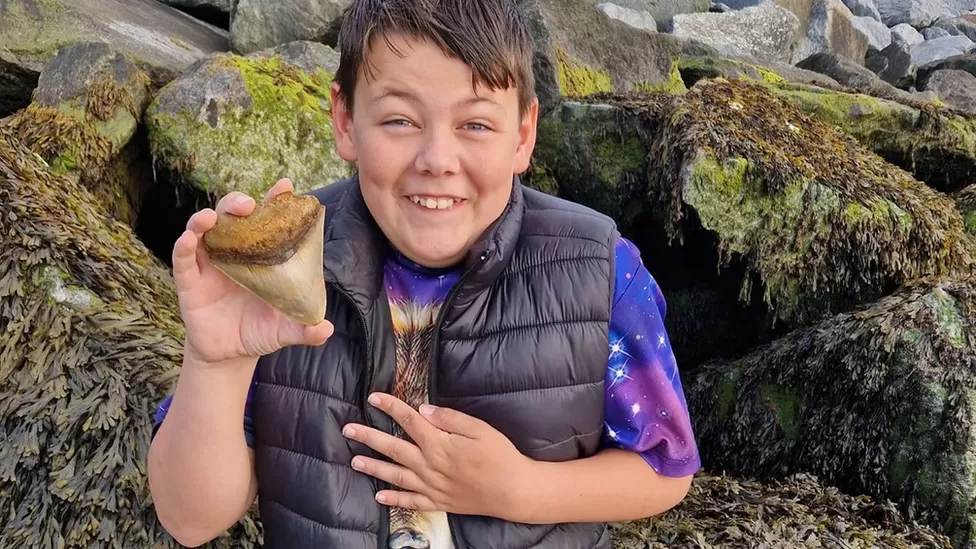Hemel Hempstead boy finds megalodon shark tooth at Walton-on-the-Naze

A 13-year-old boy has found a shark tooth belonging to a giant prehistoric creature on the Essex coast.
Ben discovered the 10cm-long (4in) tooth at Walton-on-the-Naze during a summer holiday weekend break.
The teenager’s dad, Jason, said his son was “over the moon” with the find, which wildlife experts called “rare”.
However, The Natural History Museum said it could have been purchased in a shop and lost on the beach by someone else.
Jason and his son were on a weekend break from their home in Hemel Hempstead, Hertfordshire especially to go searching for fossils.
They arrived on Friday evening and by Sunday morning had already clocked up 16 miles (26km) of walking along the coast.
They were up at the crack of dawn on Sunday and were down at the beach first thing when Ben found the giant tooth under rocks at about 07:00 BST.
Jason, 50, said: “We could just see the edge of it, sticking out, and Ben knew straightaway it was something and pulled it out of the sand.”
The pair took their find to Essex Wildlife Trust’s Discovery Centre at Walton-on-the-Naze where they confirmed it was a megalodon tooth.
Jason said he and his son go to Walton-on-the-Naze to go fossil hunting once a year and also to the Jurassic Coast, a 95-mile (153km) long stretch of coastline in southern England.
He said Ben wants to be a palaeontologist when he is older and the giant tooth was a “great addition” to his collection.
Essex Wildlife Trust said the tooth would be from 20 million years old to 3.6 million.
The Natural History Museum, which was sent images of the tooth for identification, said: “Normally the teeth have been reworked from other deposits and rolled around which means they lose the sharp triangular shape with the serrated sides.
“This tooth shows little corrosion and its crown is near pristine and it looks like it may have been restored.
“To us this looks very similar to fossils found in Java which are regularly sold in UK fossil shops. We believe it may have been lost on the beach.”
The megalodon
The cartilaginous fish (whose skeleton is made of cartilage rather than bone) was a carnivore and had no known predators
- It could eat anything it liked, but its favourite food was whales, although seals would also have been on the menu
- Most of this shark’s hunting was in the open sea (juveniles lived closer to shore) and it attacked its prey near the surface, when it came up for air
- Megalodon could swim at high speed in short bursts so tended to rush its prey from beneath
- It would first aim to disable its prey by injuring a flipper or the tail, then once unable to swim properly, the victim would be easier to finish off
- Lived from about 20 million years ago, long after the dinosaurs became extinct 65 million years ago



